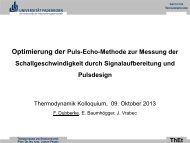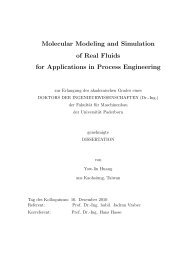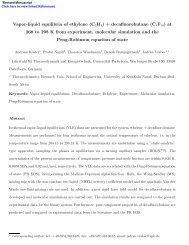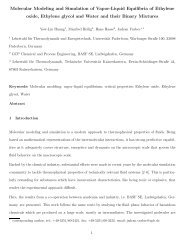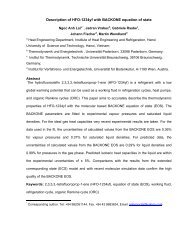ms2: A Molecular Simulation Tool for Thermodynamic Properties
ms2: A Molecular Simulation Tool for Thermodynamic Properties
ms2: A Molecular Simulation Tool for Thermodynamic Properties
Create successful ePaper yourself
Turn your PDF publications into a flip-book with our unique Google optimized e-Paper software.
3. <strong>Simulation</strong> program<strong>ms2</strong><br />
The simulation program <strong>ms2</strong> is capable of sampling the phase space <strong>for</strong> rigid electro-neutral molecules by ap-<br />
plying the two most fundamental molecular simulation techniques, i.e. MD and MC. MD simulations rely on<br />
the numerical solution of Newton’s equations of motion: <strong>for</strong> a point in time, the intermolecular interactions, in<br />
particular the resulting <strong>for</strong>ces and torques, are evaluated and treated as constant <strong>for</strong> a specified time step. They<br />
are the driving <strong>for</strong>ces of the molecular motion. The displacements <strong>for</strong> the time step are calculated on that basis,<br />
resulting in a new configuration. This process is repeated in a loop. The chronologically ordered configurations<br />
are a time discretized approximation of a molecular process. Both static and dynamic thermodynamic properties<br />
are determined via time averages. MC simulation explores the phase space stochastically <strong>for</strong> a given molecular<br />
system. Molecules in the simulation volume are displaced randomly. The probability of accepting the displace-<br />
ment is chosen such that a representative set of configurations is obtained. The Markov chain of configurations<br />
generated in this way allows <strong>for</strong> a rigorous calculation of static thermodynamic properties via ensemble averages.<br />
3.1. Overview<br />
The simulation program <strong>ms2</strong> allows <strong>for</strong> the determination of static and dynamic thermodynamic properties in<br />
equilibrium. The implemented static properties are:<br />
• Thermal and caloric properties<br />
• Chemical potential<br />
• Vapor-liquid equilibria<br />
• Henry’s law constant<br />
• Second virial coefficient<br />
The transport properties can be calculated on the fly during a MD simulation with a reasonable additional com-<br />
putational ef<strong>for</strong>t using the Green-Kubo <strong>for</strong>malism [16, 17]. The implemented dynamic properties are:<br />
• Self-diffusion coefficient<br />
• Maxwell-Stefan diffusion coefficient<br />
• Shear viscosity<br />
• Bulk viscosity<br />
The model class that is supported by <strong>ms2</strong> covers rigid multi-center Lennard-Jones (LJ) 12-6 interaction sites<br />
with an arbitrary number of superimposed electrostatic sites [18, 19, 20, 21]. The supported electrostatic models<br />
are point charges, point dipoles and point quadrupoles, which can be positioned anywhere within the molecule.<br />
Currently,<strong>ms2</strong> is designed <strong>for</strong> electro-neutral species.<br />
The quality of thermodynamic properties calculated by molecular simulation is basically determined by two fac-<br />
tors: first, the employed molecular model, i.e. the <strong>for</strong>ce field, which fully defines the thermodynamic properties<br />
5



